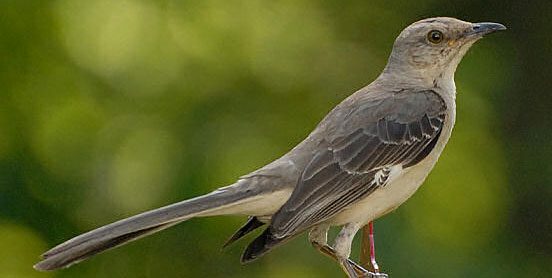Listen to the Mockingbird: A Study of Complex Song and Climate
By Laura Erickson
July 15, 2009

Cornell study finds that mimics with more complex songs are found in more unpredictable climates
A female bird has a vested interest in choosing, of all the males available to her, the one most likely to defend the highest quality territory, to father the most genetically fit offspring, and to provide the highest quality food and protection for her young. In areas with unpredictable and highly variable climates, it may be even more urgent than in milder areas for females to choose the fittest mates to help them raise their chicks. But what factors predict which male is the best choice?


In a paper published in summer 2009 in Current Biology, Cornell Lab of Ornithology alumnus Carlos Botero (now at the National Evolutionary Synthesis Center) and colleagues found that songs of mimids (birds belonging to the mockingbird family, or Mimidae) living in variable, unpredictable climates are more elaborate than songs of those living in predictable climates.
Mimids are famous for the many imitations they incorporate into their songs. The most famous species, the Northern Mockingbird, was Thomas Jefferson’s favorite bird because of its intelligence and ability to mimic. He kept a pet mockingbird named Dick in the White House, and boasted in his Notes on the State of Virginia that Great Britain’s birdlife had nothing to compare with this bird’s vocal abilities. Another mimid, the Brown Thrasher, was listed in Ripley’s Believe It or Not! after bird song authority Don Kroodsma documented one individual producing 2,400 different songs.
To measure climate variability, the researchers used data from the Global Historical Climatology Network to work out a “climate composite” that scored areas on temperature ranges, variable temperatures, and predictability of precipitation. To measure how complex a species’ songs are, they considered factors such as the number of syllable types present in three minutes of song, the average number of songs per minute, the duration of each song, and the tendency to mimic sounds of other species. Factoring in habitat and migratory behavior, they found a strong general trend in the family for birds to have more elaborate songs in more variable, unpredictable climates.
How can a bird’s song be a reliable indication of his general fitness for fatherhood? One possibility is that song serves as a sexual signal in the way that Red-winged Blackbird epaulets or Blue-footed Booby feet do. The color of plumage and bare parts in some species reflects a bird’s physiological condition and overall fitness, which can help or hinder his defense of a quality territory. Mimids in general have fairly dull plumage and males are virtually identical to females to our eyes, so males presumably don’t rely on colors to attract mates. But their songs are used both in territorial defense and in attracting mates. Producing more elaborate songs where climate is variable could relate to more intense competition among males.
Mimid songs may also serve as valid indicators of a male’s ability to learn and innovate, qualities reflecting basic intelligence and perhaps how well he would learn and innovate when raising young. The researchers will continue to investigate how well songs reflect a bird’s cognitive skills and what actual benefits a bird may get in selecting a more intelligent mate. Botero’s work was done as part of his Ph.D. research. He said, “In the eight years that I’ve spent studying mockingbirds, my initial theoretical interest in the evolution of song has grown into a full-blown passion.”
Originally published in the July 2009 issue of BirdScope.


All About Birds is a free resource
Available for everyone,
funded by donors like you




